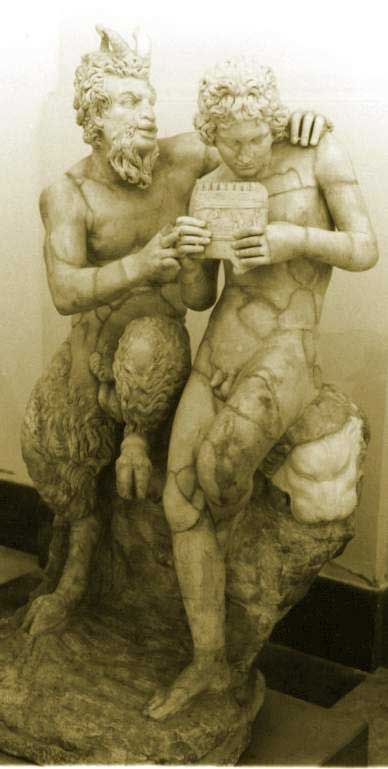.

Copy of marble sculpture by Heliodorus. Ca. 100 BC Object found at Pompeii, in the collection of the Naples Museum of Archeology Photo, 1999 An earlier description of the group is to be found in a privately printed work from 1871. In it the man/goat figure is mistakenly identified as Marsyas, and the boy as Olympus. All works subsequently published have presented the two as Pan and Daphnis. Otherwise the description (following below) is useful and informative. Haiduc 00:07, 26 November 2006 (UTC) The Royal Museum at Naples, BEING SOME ACCOUNT OF THE EROTIC PAINTINGS, BRONZES, AND STATUES CONTAINED IN THAT FAMOUS "CABINET SECRET" BY COLONEL FANIN. (Stanislas Marie César Famin, b. 1799 d. 1853) London [1871] Marsyas and Olympus Life-size. PLATE II. MARSYAS, the Satyr, the inventor, according to several mythologists, of the pastoral flute, is represented in this group, one of the masterpieces of antiquity, at the instant when, while giving lessons on that instrument to young Olympus, he is preparing to attack the chastity of his pupil. His features, on which a god-like majesty is impressed, betray the transports of his passion, to which he appears to wish to abandon himself: his mouth and nostrils open to fan the fire of concupiscence which devours his breast. His left hand rests on the youth's shoulder, as if to draw him towards him, and one of his legs, which he lifts up in order the better to secure him, leaves no doubt as to the object of his desires. The youth, meanwhile, looks down, confused and abashed; he seems to break off his music; and we fancy we see him tremble in every limb. A rock, on which a lion's skin is spread, serves as a seat for the Satyr. Olympus, a son of Meon, a native of Mysia, lived before the Siege of Troy. Plutarch attributes to him the composition of several hymns in honour of the gods. Ancient authors agree in representing him as a pupil of Marsyas, whom Pliny has confounded with Pan. Suidas speaks as follows "Olympus (a son of Meon, a Mysian), a flute-player and poet, a disciple and favourite of Marsyas. He lived before the Trojan war, and gave his name to Mount Olympus in Mysia." This subject has been several times treated by the artists of antiquity. Among others a painting was found at Herculaneum which has none of the obscenity of the group here described: Marsyas is there represented with the features of a Faun and the legs of a man. 1 According to Pliny, the invention of the pastoral flute, composed of several reeds bound together, and called fistula or syrinx, is due to Pan. 2 The above group is taken from the Farnese Museum.
Source Haiduc
See also : Greek Mythology. Paintings, Drawings
| Ancient Greece
Science, Technology , Medicine , Warfare, , Biographies , Life , Cities/Places/Maps , Arts , Literature , Philosophy ,Olympics, Mythology , History , Images Medieval Greece / Byzantine Empire Science, Technology, Arts, , Warfare , Literature, Biographies, Icons, History Modern Greece Cities, Islands, Regions, Fauna/Flora ,Biographies , History , Warfare, Science/Technology, Literature, Music , Arts , Film/Actors , Sport , Fashion --- |
Retrieved from "http://en.wikipedia.org"
All text is available under the terms of the GNU Free Documentation License

